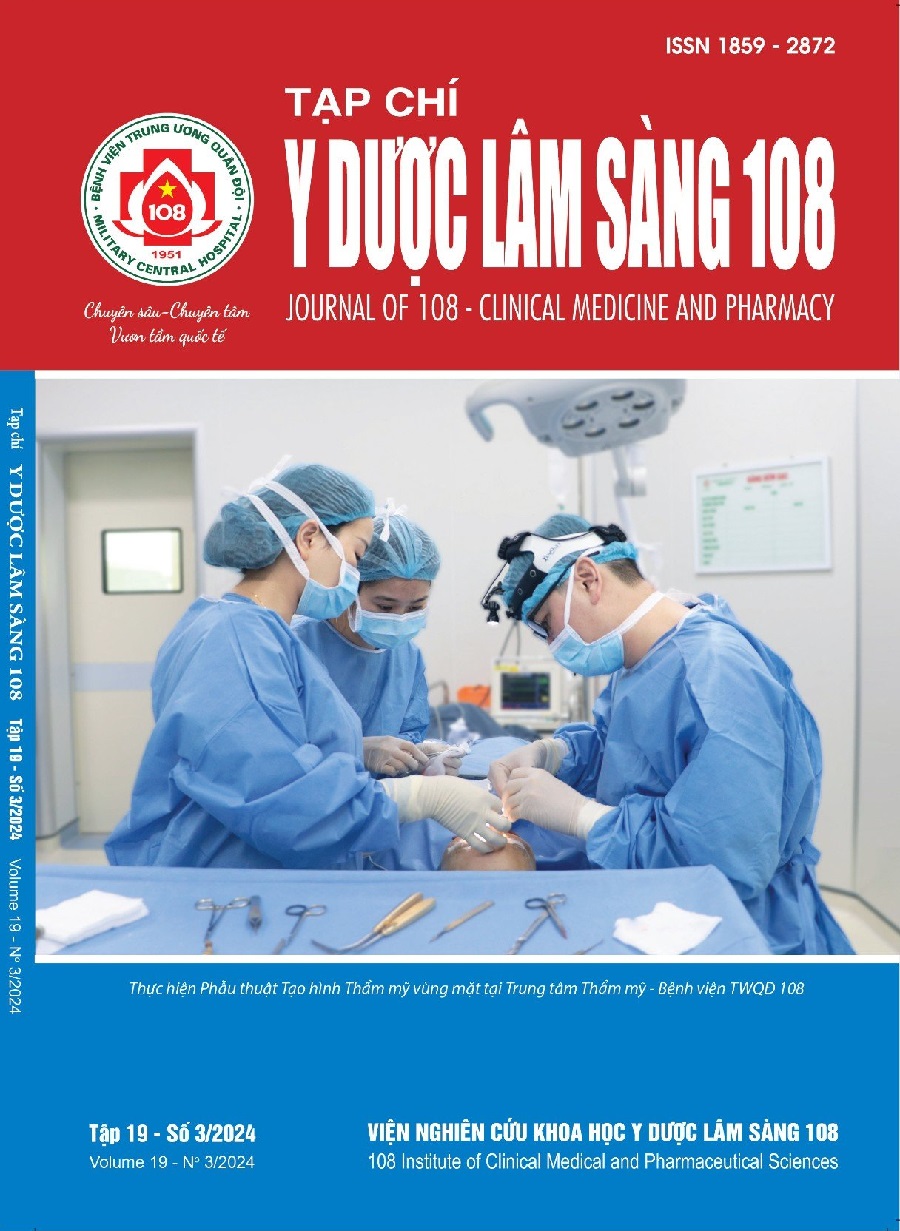Clinical and paraclinical characteristics of pediatric patients with sepsis caused by Streptococcus pneumoniae treated at the Pediatric Intensive Care Unit, Vietnam National Children’s Hospital
Main Article Content
Keywords
Abstract
Objective: To describe the clinical and paraclinical characteristics of pediatric patients with sepsis caused by S. pneumoniae treated at the Pediatric Intensive Care Unit. Subject and method: A retrospective descriptive study of a series of cases, including 46 pediatric patients from 1 month to 17 years old diagnosed with sepsis caused by S. pneumoniae treated at the Pediatric Intensive Care Unit, National Children Hospital, from January 2020 to August 2023. Result: Patients with sepsis due to S. pneumoniae were infants (median age was 16 months), 21.1% had underlying diseases, 15.2% were malnourished, and 47.8% had purulent meningitis. Severe clinical symptoms (87% septic shock, 93.5% respiratory failure requiring mechanical ventilation support, and 87% multiple organ failure). There was a high rate of mortality and neurologic sequelae (21.75% and 26.1%). The rate of S. pneumoniae isolated from the blood was 43.5%. Inflammation index increased (52.2% of children had increased white blood cells, 23.9% had decreased white blood cells, 47.4% had CRP > 10mg/L, 39.1% had anemia (Hb < 10g/L), 69.6% had albumin < 35g/L, 60.9% had lactate above 2.0mmol/L, 32.6% had pH below 7.25 and a high rate of coagulation disorders (81.8% had D-dimer above 500mg/L). The percentage of children with underlying diseases, isolated S. pneumoniae from the blood, failure of 3 or more organs, septic shock, lactate above 2.0mmol/L, pH ≤ 7.25, VIS index, PRISM III score of the death group was higher than the survival group (p<0.05). Pediatric patients with sepsis caused by S. pneumoniae with underlying diseases had a 20.39 times higher risk of death than the group without underlying conditions (CI: 1.502-276.67, p = 0.023). The underlying disease was an independent risk factor of mortality in pediatric patients with sepsis caused by S. pneumoniae. Conclusion: Clinical and paraclinical characteristics of pediatric patients with sepsis caused by S. pneumoniae were severe. Patients with septicemia due to S. pneumoniae who had an underlying disease were an independent risk factor related to the death of this disease.
Article Details
References
2. Đào Hữu Nam, Nguyễn Thị Hồng Hà, Nguyễn Phương Hạnh và cộng sự (2023) Mối liên quan giữa nồng độ đáy vancomycin và kết quả điều trị viêm màng não Streptococcus pneumoniae ở trẻ em. Tạp chí Y dược Lâm sàng 108, 2023. Tập 18 - Số đặc biệt tháng 10/2023.
3. Nguyễn Đăng Quyệt, Đào Minh Tuấn, Bùi Quang Phúc và Trương Thị Việt Nga (2021) Tình hình đề kháng kháng sinh của Streptococcus pneumoniae và kết quả điều trị viêm phổi do Streptococcus pneumoniae ở trẻ em tại Bệnh viện Nhi Trung ương. Tạp chí Nghiên cứu và Thực hành Nhi khoa, 5(4), tr. 27-34.
4. Rudd KE, Johnson SC, Agesa KM et al (2020) Global, regional, and national sepsis incidence and mortality, 1990-2017: Analysis for the global burden of disease study. Lancet, 2020. 395(10219): 200-211.
5. Agyeman PKA, Schlapbach LJ, Giannoni E et al (2017) Epidemiology of blood culture-proven bacterial sepsis in children in Switzerland: A population-based cohort study. Lancet Child Adolesc Health 1(2): 124-133.
6. Goldstein B, Giroir B, Randolph A (2005) International pediatric sepsis consensus conference: Definitions for sepsis and organ dysfunction in pediatrics. Pediatr Crit Care Med 6(1): 2-8.
7. Vijayakumary T and Kavinda D (2021) Review on pneumococcal infection in children. Cureus 13(5): 14913.
8. Li Q, Li Y, Yi Q et al (2019) Prognostic roles of time to positivity of blood culture in children with Streptococcus pneumoniae bacteremia. Eur J Clin Microbiol Infect Dis 38(3): 457-465.
9. Weiss SL, Balamuth F, Hensley J et al (2017) The Epidemiology of hospital death following pediatric severe sepsis: When, why, and how children with sepsis die. Pediatr Crit Care Med 18(9): 823-830.
 ISSN: 1859 - 2872
ISSN: 1859 - 2872
